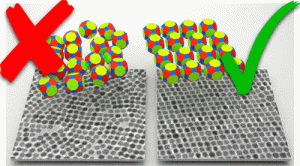Congratulations to Jessica, Daniel and Tyler for publishing the methods paper “Fundamental Processes and Practical Considerations of Lead Chalcogenide Mesocrystals Formed via Self-Assembly and Directed Attachment of Nanocrystals at a Fluid Interface” in Chemistry of Materials

We have been intrigued by mesocrystals formed from colloidal nanocrystal building blocks and have been fortunate to contribute to the impressive recent advances in this field. In particular, epitaxially-connected lead chalcogenide superlattices present many interesting scientific and technological challenges spanning fundamental materials chemistry to emerging optoelectronic properties. Theory predicts that the underlying balance between quantum confinement and quantum coupling will give rise to exotic phenomena like topologically protected spin-polarized states; however, synthesis and fabrication methods have, so far, not yet been able to create superlattices with the requisite structural fidelity to probe and explore these predictions. The formation of the epitaxially connected superlattices involves a complex choreography of multiple physicochemical processes. Beyond assembling the constituent nanocrystals into arrangements with high spatial and orientational ordering, the process must also be coordinated to achieve the directed attachment of neighboring dots. Remarkably, the epitaxial bonding of dots involves the irreversible attachment of on the order of 10^5 dots to form a μm-scale superlattice grain. Perhaps not surprisingly, this assembly and attachment process is very sensitive to the processing conditions, choice of solvents, subphase, and preparation of the colloidal NC building blocks. We wrote this methods and protocols paper to share our best practices with the community and to provide, as far as possible, our understanding the fundamental relationship between processing conditions and mechanistic impacts leading to the formation of high-fidelity superlattices. Given the strong scientific interest in mesocrystalline materials, we hope that better understanding of the processing /structure relationships will spur on further advances in this blossoming field. Again, congrats to Jessica, Daniel and Tyler.

